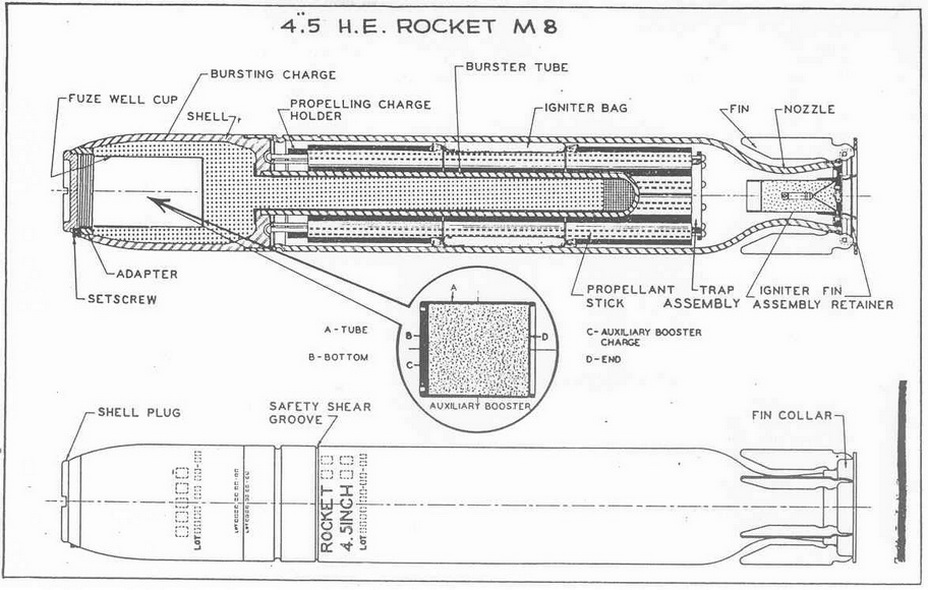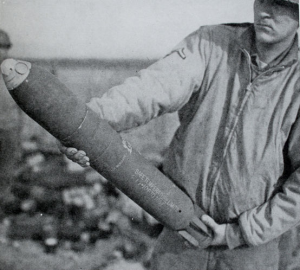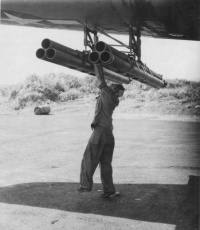Difference between revisions of "M8"
m (Edits.) |
(Added information and images.) |
||
| Line 1: | Line 1: | ||
| + | {{DISPLAYTITLE:M8}} | ||
| + | <div class="ttx"> | ||
| + | <div class="ttx-image">[[File:4.5_in_M8_rocket_diagram.jpg]] | ||
| + | <div class="ttx-table"> | ||
| + | <div class="ttx-table-line ttx-table-head">M8</div> | ||
| + | <div class="ttx-table-line"><span class="ttx-value">Unguided Rocket</span><span class="ttx-name">Type</span></div> | ||
| + | <div class="ttx-table-line"><span class="ttx-value">USA [[File:CountryIcon USA.png|link=]]</span><span class="ttx-name">Country of origin</span></div> | ||
| + | <div class="ttx-table-line ttx-table-head">Production History</div> | ||
| + | <div class="ttx-table-line"><span class="ttx-value">Picatinny Arsenal</span><span class="ttx-name">Designer</span></div> | ||
| + | <div class="ttx-table-line"><span class="ttx-value">1941 - 1944</span><span class="ttx-name">Produced</span></div> | ||
| + | <div class="ttx-table-line ttx-table-head">Specifications</div> | ||
| + | <div class="ttx-table-line"><span class="ttx-value">38 lb (17 kg)</span><span class="ttx-name">Missile mass</span></div> | ||
| + | <div class="ttx-table-line"><span class="ttx-value">33 in (840 mm)</span><span class="ttx-name">Length (normal)</span></div> | ||
| + | <div class="ttx-table-line"><span class="ttx-value">4.5 in (110.0 cm)</span><span class="ttx-name">Diameter (normal)</span></div> | ||
| + | <div class="ttx-table-line"><span class="ttx-value">TNT</span><span class="ttx-name">Explosive warhead</span></div> | ||
| + | <div class="ttx-table-line"><span class="ttx-value">4.8 lb (2.0 kg)</span><span class="ttx-name">Explosive mass</span></div> | ||
| + | <div class="ttx-table-line ttx-table-head">Other Information</div> | ||
| + | <div class="ttx-table-line"><span class="ttx-value">4,600 yd (4.6 km)</span><span class="ttx-name">Maximum firing range</span> | ||
| + | </div> | ||
| + | <div class="ttx-table-line"><span class="ttx-value">600 mph (970 km/h)</span><span class="ttx-name">Speed</span></div> | ||
| + | <div class="ttx-table-line"><span class="ttx-value">None</span><span class="ttx-name">Guidance System</span></div> | ||
| + | </div> | ||
| + | </div> | ||
| + | </div> | ||
== Description == | == Description == | ||
| − | ''Write an introduction to the article in 2-3 small paragraphs. Briefly tell us about the history of the development and combat using the weaponry and also about its features. Compile a list of air, ground, or naval vehicles that feature this weapon system in the game.'' | + | <!--''Write an introduction to the article in 2-3 small paragraphs. Briefly tell us about the history of the development and combat using the weaponry and also about its features. Compile a list of air, ground, or naval vehicles that feature this weapon system in the game.''--> |
| + | The 4.5-inch (110 mm) '''{{PAGENAME}}''' fin-stabilized rocket is approximately 33 in (0.83 m) in length and 40 lb (18.1 kg) and is almost an equivalent of a 105 mm Shell M1. This rocket utilises an M4 fuze which explodes after a 0.015-sec delay set off by auxiliary M1 booster. | ||
| + | |||
| + | The components of the rocket break down into three separate sections, the fuze, shell and motor body. The shell of the rocket or the head is made up of a warhead body fitted with a burster tube. The burster tube itself extends from the shell through the rocket body and through the rocket motor, the purpose of this is to expand the explosive capability of the rocket by utilising the rocket motor as an additional source of fragmentation in the explosion. Once fired, folding fins around the tail flange will extend and spin stabilise the rocket. | ||
| + | |||
| + | The M8 rocket requires a tube launcher to launch (as opposed to being installed directly to external hardpoints) and this accomplished by mounting an M10 cluster launcher to the underside of the aircraft’s wings or fuselage belly. The M10 is a cluster of three 10-foot tubes manufactured from plastic (M14s are made from steel and M15s are constructed of magnesium alloy) and are banded together in six places and are secured to the aircraft via two mounting straps, front and rear. The rear strap also bears the electrical connections which link up to the rockets once in the tubes as the firing links. The release and contact mechanisms are protected from flying links and fired casings ejected from the wing guns to prevent accidental damage or drop release of the M10 launcher. | ||
=== Vehicles equipped with this weapon === | === Vehicles equipped with this weapon === | ||
| Line 13: | Line 42: | ||
== General info == | == General info == | ||
''Tell us about the tactical and technical characteristics of the bomb.'' | ''Tell us about the tactical and technical characteristics of the bomb.'' | ||
| + | [[File:M8_4.5in_fin_stabilized_rocket.png|300px|thumb|right|A soldier holding an '''{{PAGENAME}}''' rocket prior to loading in a launch tube.]] | ||
=== Effective damage === | === Effective damage === | ||
| − | ''Describe the type of damage produced by this type of bomb (high explosive, splash damage, etc)'' | + | <!--''Describe the type of damage produced by this type of bomb (high explosive, splash damage, etc)''--> |
| + | The M8 rocket is a 40 lb (18.1 kg) high explosive mass with a TNT warhead which travels at 600 mph (970 km/h). After slamming into a target a slight delay will set off the explosive mass of the missile causing the TNT shell to detonate along with fragmenting the rocket body and motor. Damage is caused by both the high explosives and fragmentation. | ||
=== Comparison with analogues === | === Comparison with analogues === | ||
| Line 21: | Line 52: | ||
== Usage in battles == | == Usage in battles == | ||
| − | ''Describe situations when you would utilize this bomb in game (vehicle, pillbox, base, etc)'' | + | <!--''Describe situations when you would utilize this bomb in the game (vehicle, pillbox, base, etc)''--> |
| + | The M8 rockets are typically mounted on an aircraft in groups of three (usually two launchers of three) or a total of 16 on the boat [[Higgins 78 ft PT-200]]. The M8 rocket is typically best utilised against personnel, installations and light armoured vehicles due to the fantastic fragmentation of this rocket upon impact and explosion. | ||
=== Pros and cons === | === Pros and cons === | ||
| − | ''Summarize and briefly evaluate the weaponry in terms of its characteristics and combat effectiveness. Mark pros and cons as a list.'' | + | <!--''Summarize and briefly evaluate the weaponry in terms of its characteristics and combat effectiveness. Mark pros and cons as a list.''--> |
'''Pros:''' | '''Pros:''' | ||
| − | * | + | * Lightweight, able to mount on fighter aircraft |
| + | * SHOOTIN' ROCKETS!! | ||
'''Cons:''' | '''Cons:''' | ||
| − | * | + | * Inaccurate, best fired in groups to increase the chance of hitting a target |
| + | * Increases aerodynamic drag, decreasing flight efficiency | ||
== History == | == History == | ||
| Line 36: | Line 70: | ||
== Media == | == Media == | ||
| − | ''An excellent addition to the article would be a video guide, as well as screenshots from the game and photos.'' | + | <!--''An excellent addition to the article would be a video guide, as well as screenshots from the game and photos.''--> |
| + | <div><ul> | ||
| + | <li style="display: inline-block;"> [[File:A-20_4.5in-M8rockets.jpg|thumb|none|200px|Image of ground crew member adjusting '''{{PAGENAME}}''' rocket launch tubes under the wing of an [[A-20G-25]].]] </li> | ||
| + | <li style="display: inline-block;"> [[File:P-47D_with_bazooka_rocket_tubes.jpg|thumb|none|200px|Crew members loading '''{{PAGENAME}}''' rocket tubes under the wing of an [[P-47 (Family)|P-47D]] in Saipan, 1944.]]</li><!-- | ||
| + | <li style="display: inline-block;"> [[File:Tiny Tim Info pg49.png|thumb|none|200px|Description of the '''{{PAGENAME}}''' rocket.]]</li> | ||
| + | <li style="display: inline-block;"> [[File:Tiny Tim Info pg50.png|thumb|none|200px|Further diagram of '''{{PAGENAME}}''' rocket.]]</li> | ||
| + | <li style="display: inline-block;"> [[File:Tiny Tim Info pg51.png|thumb|none|200px|Continued description of the '''{{PAGENAME}}''' rocket.]]</li>--> | ||
| + | </ul></div> | ||
== See also == | == See also == | ||
| Line 44: | Line 85: | ||
== External links == | == External links == | ||
| − | ''Paste links to sources and external resources, such as:'' | + | <!--''Paste links to sources and external resources, such as:'' |
* ''topic on the official game forum;'' | * ''topic on the official game forum;'' | ||
* ''encyclopedia page on the weapon;'' | * ''encyclopedia page on the weapon;'' | ||
| − | * ''other literature.'' | + | * ''other literature.''--> |
| + | * [http://bulletpicker.com/pdf/USNBD%20-%20US%20Rockets%20and%20Fuzes.pdf US Rockets and Fuzes - United States Navy Bomb Disposal Manual, 15 May 1945, pg. 14] | ||
{{Rockets}} | {{Rockets}} | ||
Revision as of 18:22, 26 April 2019

Contents
Description
The 4.5-inch (110 mm) M8 fin-stabilized rocket is approximately 33 in (0.83 m) in length and 40 lb (18.1 kg) and is almost an equivalent of a 105 mm Shell M1. This rocket utilises an M4 fuze which explodes after a 0.015-sec delay set off by auxiliary M1 booster.
The components of the rocket break down into three separate sections, the fuze, shell and motor body. The shell of the rocket or the head is made up of a warhead body fitted with a burster tube. The burster tube itself extends from the shell through the rocket body and through the rocket motor, the purpose of this is to expand the explosive capability of the rocket by utilising the rocket motor as an additional source of fragmentation in the explosion. Once fired, folding fins around the tail flange will extend and spin stabilise the rocket.
The M8 rocket requires a tube launcher to launch (as opposed to being installed directly to external hardpoints) and this accomplished by mounting an M10 cluster launcher to the underside of the aircraft’s wings or fuselage belly. The M10 is a cluster of three 10-foot tubes manufactured from plastic (M14s are made from steel and M15s are constructed of magnesium alloy) and are banded together in six places and are secured to the aircraft via two mounting straps, front and rear. The rear strap also bears the electrical connections which link up to the rockets once in the tubes as the firing links. The release and contact mechanisms are protected from flying links and fired casings ejected from the wing guns to prevent accidental damage or drop release of the M10 launcher.
Vehicles equipped with this weapon
| Vehicles equipped with this weapon | |
|---|---|
| Fighters | P-39N-0 · P-39Q-5 · P-47D-28 · P-51D-5 · P-51D-10 · P-51D-20-NA · P-51D-30 · P-51H-5-NA |
| Twin-engine fighters | P-38G-1 · XP-38G · P-38J-15 · Bong's P-38J-15 |
| Attackers | A-20G-25 |
| Ships | PT-200 |
General info
Tell us about the tactical and technical characteristics of the bomb.
Effective damage
The M8 rocket is a 40 lb (18.1 kg) high explosive mass with a TNT warhead which travels at 600 mph (970 km/h). After slamming into a target a slight delay will set off the explosive mass of the missile causing the TNT shell to detonate along with fragmenting the rocket body and motor. Damage is caused by both the high explosives and fragmentation.
Comparison with analogues
Give a comparative description of bombs that have firepower equal to these type of weapons.
Usage in battles
The M8 rockets are typically mounted on an aircraft in groups of three (usually two launchers of three) or a total of 16 on the boat Higgins 78 ft PT-200. The M8 rocket is typically best utilised against personnel, installations and light armoured vehicles due to the fantastic fragmentation of this rocket upon impact and explosion.
Pros and cons
Pros:
- Lightweight, able to mount on fighter aircraft
- SHOOTIN' ROCKETS!!
Cons:
- Inaccurate, best fired in groups to increase the chance of hitting a target
- Increases aerodynamic drag, decreasing flight efficiency
History
Examine the history of the creation and combat usage of this weapon. If the historical reference turns out to be too big, take it to a separate article, taking a link to an article about the vehicle and adding a block "/ History" (example: https://wiki.warthunder.com/(weapon-name)/History) and add a link to it here using the main template. Be sure to reference text and sources by using <ref>, as well as adding them at the end of the article.
Media
See also
Links to the articles on the War Thunder Wiki that you think will be useful for the reader, for example:
- reference to the article about the variant of the weapon;
- references to approximate analogues by other nations and research trees.
External links
| Naval special armaments | |
|---|---|
| USA | |
| Mortars | 7.2-inch T37 · Mk 2 |
| Rockets | 5-inch GPSR Mk.7 · Mark 108 Weapon alfa |
| Missiles | RIM-24A |
| Germany | |
| Rockets | M/50 Bofors |
| Missiles | Strela-2M |
| USSR | |
| Mortars | BM-37 · RBM · RBU-1200 · RBU-2500 · RBU-6000 · RKU-36U |
| Rockets | BM-14-17 · BM-21 · M13 · M-8 |
| Missiles | Volna-M |
| Britain | |
| Mortars | Ordnance ML 4.2-inch mortar |
| Japan | |
| Rockets | 4.5-inch BBR Mk.7 (USA) · Mark 108 Weapon alfa (USA) |
| Italy | |
| Missiles | Nettuno |
| France | |
| Missiles | SS.11 |






